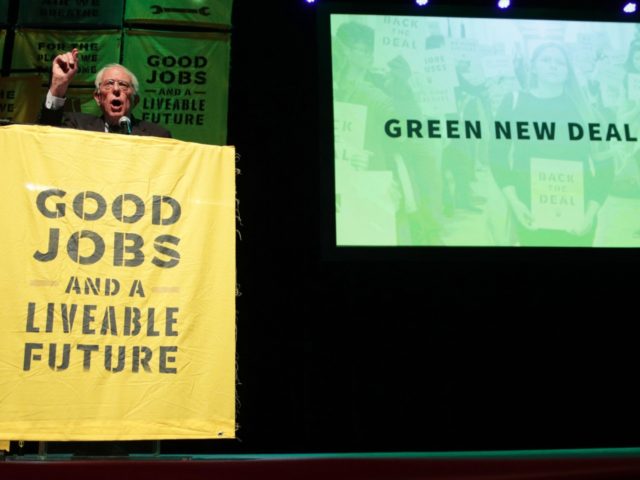Sen. Bernie Sanders (I-VT) released his plans for a Green New Deal, accompanied by a monstrous $16 trillion price tag.
Sanders calls climate change the “single greatest challenge facing our country,” citing “extreme” weather phenomena like floods, droughts, wildfires, and hurricanes, despite the fact that those occurrences have existed since the beginning of time. Sanders even suggests that climate change has a racial element to it, arguing the effects of climate change affect “communities of color,” particularly.
He warns “immediate” action is necessary, likening the “crisis” to the challenges former President Franklin D. Roosevelt faced in the 1940s, leading to the creation of the New Deal.
Sanders’ plan promises to effectively reverse the “crisis” while simultaneously creating 20 million jobs and reaching “100 percent renewable energy for electricity and transportation by no later than 2030 and complete decarbonization by at least 2050,” per the United Nations Intergovernmental Panel on Climate Change’s guidelines.
A $16.3 trillion public investment is necessary to make those goals a reality, which falls in line with Rep. Alexandria Ocasio-Cortez (D-NY), who said any viable climate change plan needed to come with a $10 trillion price tag – at least– in order to “have a shot.”
Sanders says we must “directly invest a historic $16.3 trillion public investment toward these efforts, in line with the mobilization of resources made during the New Deal and WWII, but with an explicit choice to include black, indigenous and other minority communities who were systematically excluded in the past.”
However, he claims the investment will effectively “pay for itself” over 15 years and that the price of inaction will cost far more, citing experts who say that doing nothing will cost the U.S. “$34.5 trillion in economic activity” by 2100. He plans to pay for the $16.3 trillion plan with additional taxes on the fossil fuel industry, and he plans to “prosecute and sue” them for the damage ravaged on the planet.
Sanders’ exhaustive plan covers virtually every angle of the climate change “crisis,” from promising to “fully electrify and decarbonize” the transportation sector, to investing $1.12 billion in “tribal land access and extension programs,” to providing “oral translation assistance to USDA, FDA, and DOJ offices for non-English speaking farmers,” to pouring $200 billion in the Green Climate Fund:
Despite the major shortcomings of the Paris Climate Agreement, one primary reason why the globe was able to come together to sign the Paris Climate Agreement was that major developed nations like the United States finally recognized that they had an outsized role in the creation of the climate crisis, and an outsized obligation to less industrialized nations to help them achieve the same kind of carbon pollution emissions reductions while improving the quality of life in those countries. In order to help countries of the global south with climate adaptation efforts, the U .S . will invest $ 200 billion in the Green Climate Fund for the equitable transfer of renewable technologies, climate adaptation, and assistance in adopting sustainable energies. U.S. leadership can ensure that the developing world secures reliable electricity, reduces poverty and pollution-related fatalities, creates greater net employment, and improves living standards all while reducing greenhouse- gas emissions.
Sanders also uses his plan as a pitch to drastically expand existing entitlement programs, like the Supplemental Nutrition Assistance Program (SNAP) and the Low -Income Home Energy Assistance Program (LIHEAP).
The plan states in part:
Energy assistance. While we do not expect energy prices to spike because the federal government is going to weatherize homes, electrify heating, and keep electricity prices stable, we still want to ensure that families are protected during the transition. We will expand the Low -Income Home Energy Assistance Program (LIHEAP) by $ 25 billion to help low-income families pay their heating and cooling bills. Additionally, the program will be expanded to provide 10 percent of program costs for maintenance of new efficient heating and cooling systems and technical assistance for the installation and use of new furnaces, heat pumps, boilers, and other upgrades for the duration of the 10-year transition.
Ensure a hunger- free transition. Because the cost of energy and food are so intertwined, we will provide $ 215 . 8 billion for free, universal school meals, including breakfast, lunch and snacks. We will expand the Supplemental Nutrition Assistance Program (SNAP) by $311billion to increase the benefits from the ” thrifty plan which provides inadequate benefits to the more generous low-cost food plan, include those with incomes up to 200 percent of the federal poverty line, remove punitive work requirements, remove barriers for college students to access SNAP , and ensure are not denied benefits due to past interaction with the criminal justice system . We will also expand the SNAP program and benefits to the people of Puerto Rico, the Northern Mariana Islands, and American Samoa so they are on par with the benefits in the continental United States.
“We need a president who has the courage, the vision, and the record to face down the greed of fossil fuel executives and the billionaire class who stand in the way of climate action,” his plan states.
“We need a president who welcomes their hatred. Bernie will lead our country to enact the Green New Deal and bring the world together to defeat the existential threat of climate change,” it continues.
The release of Sanders’ plan comes on the heels of Gov. Jay Inslee’s (D) departure from the presidential race. Inslee was the only candidate to build his entire campaign on the sole issue of climate change.
“I have seven grandchildren, and I’m going to be damned if I’m going to leave them a planet that is unhealthy and uninhabitable,” Sanders told the New York Times.

COMMENTS
Please let us know if you're having issues with commenting.